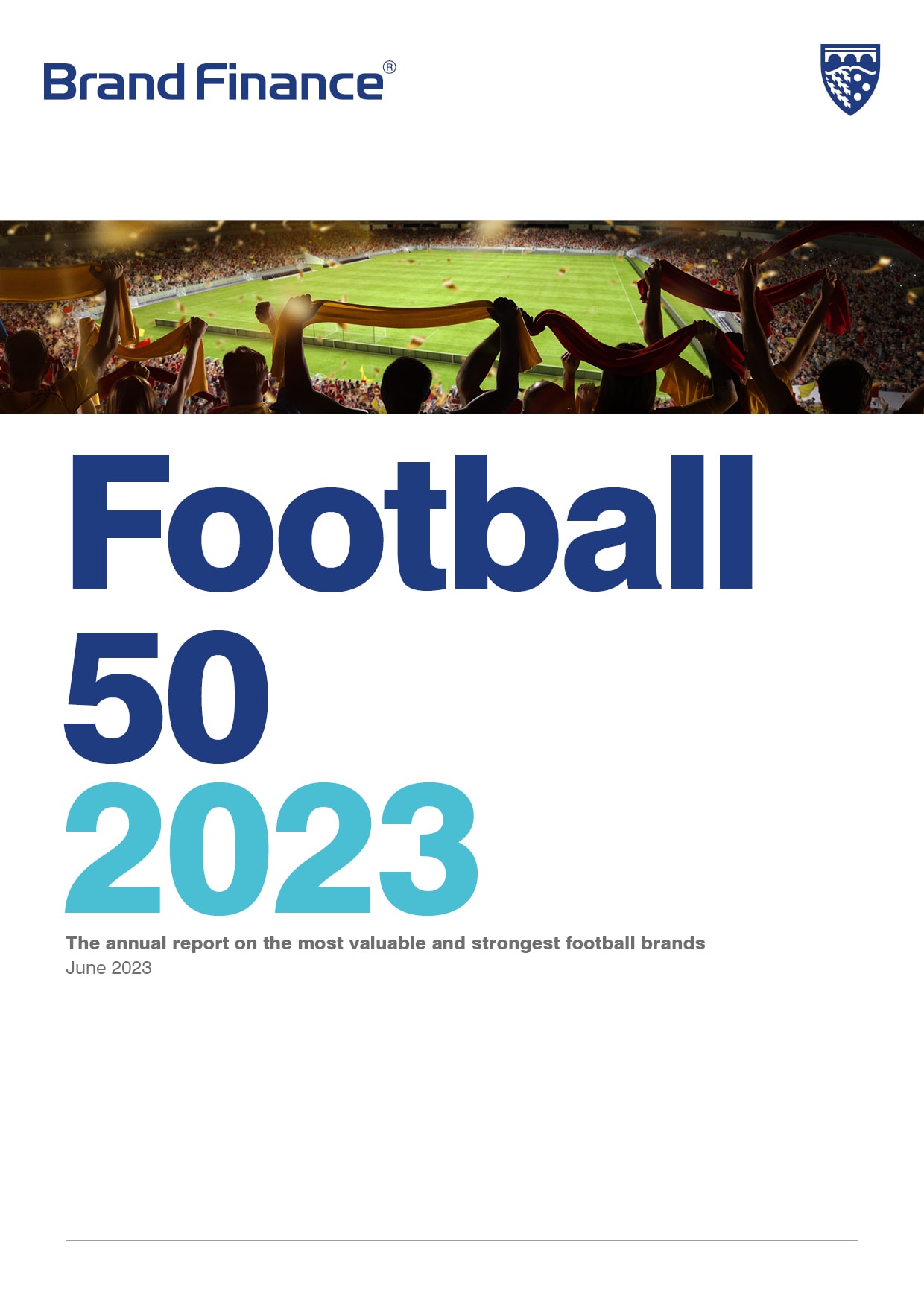This article was originally published in the Brand Finance Football 50 2023.
Interview with Andy Pottinger and Paul Eddleston

Director – Venue Design,
Buro Happold
How to make your vision visible in the next era of stadium development
Club owners and executives, take note. You all have important decisions to make regarding your venue in the coming years, decisions that will have a significant impact on the reputation of your club in the future. Sport has had challenges in the past with commercial deals with the tobacco, alcohol and most recently gambling industries so many clubs are actively and imaginatively positioning themselves as forces for good, some more successfully than others. We asked two experts from Buro Happold about howsh stadia can positively or negatively impact public perception of the club’s attitude to sustainability and the climate crisis.
How can football clubs move away from negative perceptions and position themselves as a force for good?

Associate – Venue Design,
Buro Happold
Paul: The obvious answer is by visibly choosing a sustainable future and helping others to achieve sustainable futures. With the significance of the climate crisis requiring urgent changes to the way we live, the population are making more ethical and sustainable choices, especially the younger population - a generalisation, but sometimes generalisations are unavoidable. And many of those people are prepared to dive into the data, rather than just be fed information. As a result, sponsors are opting to partner with clubs and venues who are challenging the status quo and leading the way. Likewise, investors. Yet, as time goes by, clubs will no longer be able to stand apart by simply talking about reducing their plastic use and increasing their vegan options, however commendable that might be. It’s already becoming less of a differentiator, so what is the next era?
Andy: When comparing sustainability characteristics of venues for our Venue Performance Rating (as published in previous ‘Football 50’ annuals) we asked ourselves this question, ‘Who is truly and demonstrably lifting themselves above the crowd when it comes to sustainable venue design?’ In our view, the leadership space is still there to be grabbed, certainly among the larger clubs. By venue design, I’m talking of the physical entity. Many clubs have upped their game regarding club and venue operations, and the various sustainability leagues have shone a light on this, but new stadiums and stands are broadly similar to what would have been built 20 years ago.
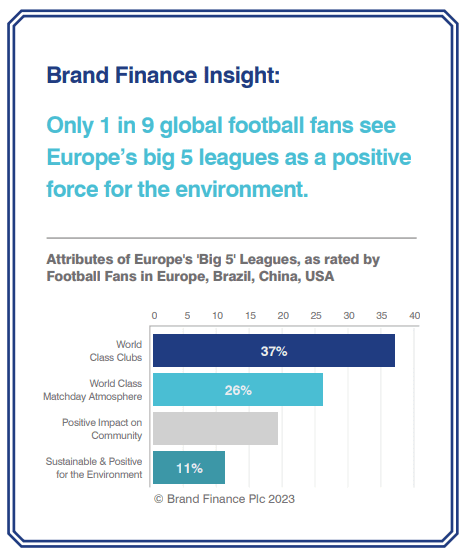
Many clubs that we speak to are developing their venues (new or adapted) with the UN Sustainable Development goals in mind, which is fantastic, but is there a chance to really stand apart and attract more sponsorship and investment than your rivals? Can you authentically make the world a better place and grab the space as pioneers? Not in a greenwash sense, but literally pioneers, defined as ‘one of the first to do something.’
‘Can you authentically make the world a better place and grab the space as pioneers?’
Carbon-neutral stadiums already exist, don’t they?
Paul: The media use of the term Carbon-neutrality usually refers to operations only. In recent years operators and designers have certainly addressed emissions strongly, focusing on building environment systems, energy strategies and waste strategies. And this is all positive, but the definition of net zero carbon now includes the carbon emissions generated in construction (known as embodied carbon). Consider this:
- 40% of global emissions come from buildings and construction
- 8% of global emissions come from cement alone
- 11% of global emissions come from the steel and iron industry
Andy: Operational carbon is a positive story; it’s dropping all the time because of the decarbonisation of national power grids, especially across Europe. We would all like it to drop faster, but fossil fuels are on the way out so the energy consumption in the stadium, the energy used to get to the stadium, the energy used to make the products within the stadium, etc. is gradually creating less and less carbon emissions.
So, by 2030 the embodied carbon of new stadiums and stands will be far, far more significant than the operational carbon that follows in-use. Yet embodied carbon hasn’t been attacked to the same degree as operational carbon, so it’s hard to argue that any major net-zero stadiums really exist yet.
‘By 2030 ‘embodied carbon’ will be far more significant than operational carbon… it’s hard to argue that any major net-zero stadiums really exist yet.’
Does the football world really understand what embodied carbon is?
Paul: Generally speaking, no. The bombardment of media headlines about carbon-neutral stadiums and events is in danger of creating complacency. Put simply, there is only one route to net-zero construction - you create tonnes of carbon emissions during construction and then you pay for that by offsets or the export of renewable energy.
So, in some ways it’s like someone paying a fine. They’ve done something bad and then they compensate. They’ve paid the price, but no-one is going to consider them a hero are they. And in the years to come this will all become far more visible to the public.
‘There is only one route to net-zero construction - you create tonnes of carbon emissions during construction and then you pay for that by offsets or the export of renewable energy.‘
Andy: Exactly, so the opportunity here is to hugely reduce the carbon emissions during construction, and to be recognised for doing so. The public can then see the seriousness with which you are treating the climate crisis AND you don’t need to pay as much in offsets.
The crisis we are in requires so much more, and the opportunity to be ‘in the forward line’ of changing the world will offer commercial benefits as sponsors and partners look to associate themselves with those that visibly share their values.
‘The opportunity to be ‘in the forward line’ of changing the world will offer commercial benefits as sponsors and partners look to associate themselves with those that visibly share their values’
So, how can a club be in the forward line?
Paul: Put yourselves in the position of a fan, sponsor, investor approaching a stadium. What would influence their perception of low embodied carbon? Certainly, a sensitive refurbishment of a tired but loved venue would score highly. So would timber and lightweight design. So would a design which facilitates renewable energy generation. So would integration with nature. It’s hard to think of many major stadiums in Europe that create this perception.
Is it still ok to knock down an existing stand or stadium?
Andy: ‘Can we refurbish?’ certainly needs to be considered more substantially than it has been. The world is blessed with engineers and architects that can overcome all but the largest obstacles. The Climate Pledge Arena in Seattle has rightfully gained credit for the re-use of its existing roof; the refurbishments of Camp Nou and Santiago Bernebeu are ongoing. To take a non-venue example, our practice recently played a leading role in the refurbishment of Battersea Power Station in London.
There were hundreds of problems with refurbishment, hundreds of reasons for building somewhere else, but these problems and reasons to do otherwise were all overcome, and the result is something that opened its doors with ‘instant history’ and ‘instant iconicity.’
The likes of Old Trafford and the San Siro could be reimagined using the same structural fabric – incredibly challenging-yes, impossible-no.
The result would be something that would give the sustainability reputations of those clubs ‘Champions League status’ and lift them above their rivals.
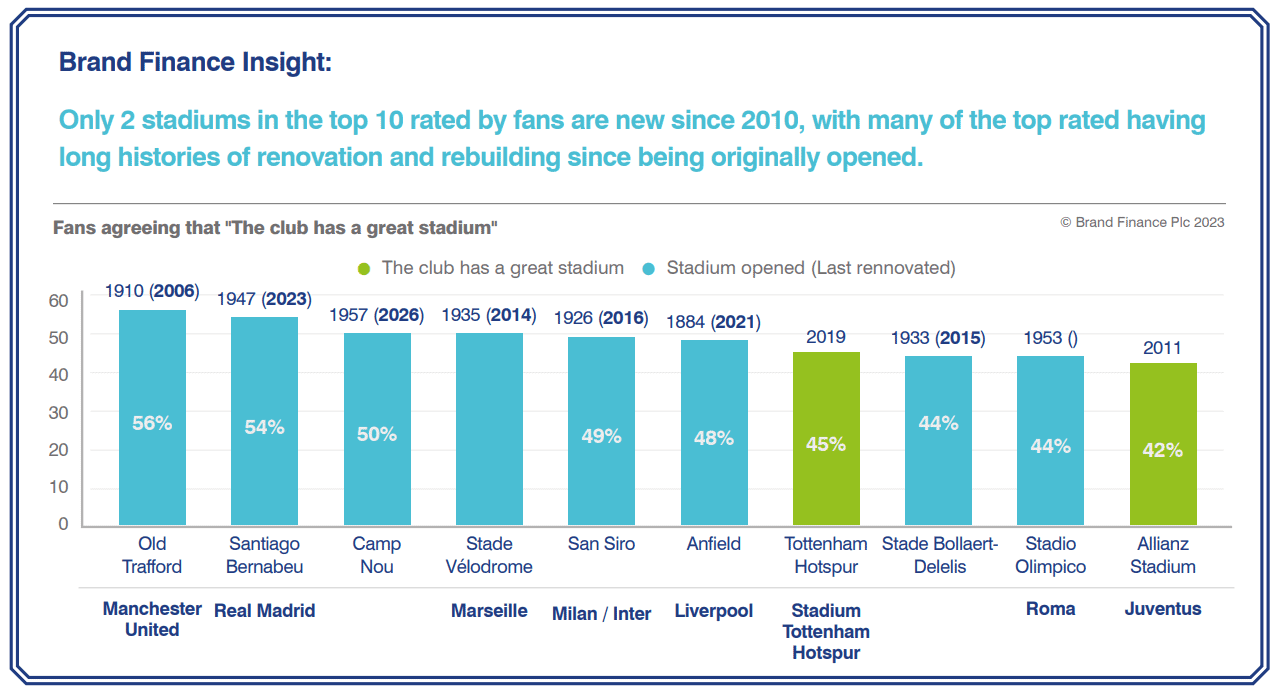
‘Can we refurbish?’ certainly needs to be considered more substantially than it has been’
If you feel you have no choice but to build a new stand or stadium, what can you do?
Andy: Use as little new material as you can and create a design that touches the ground lightly.
Forget basements. Consider timber stands and roofs, the fire concerns of the past can be addressed now. Champion new material technology – for example, the potential for net-zero carbon concrete and green steel is there, but it needs a trailblazer.
Plant-based composites are so exciting but need a shove to become mainstream. Building and consuming less is fundamental, but technological breakthroughs are needed as well. Imagine the brand benefits of being the club who builds a stadium or stand that influences all those that come after it!
Imagine the brand benefits of being the club who builds a stadium or stand that influences all those that come after it!
Paul: On top of what Andy has said, clubs should look to lead the way in broader aspects of sustainability. The global pandemic showed examples of opening stadiums for uses not previously considered. Unlocking the doors to the stadium on non-matchdays can offer significant social and economic benefit to the community and change the perception of club brand from ‘for the wealthy’ to ‘for the people.’
The Director of the stadium project for Real Betis recently stated ‘This is not just your stadium, it’s your home. And it also has an impact on all lines of business, on our audiences and on our commercial value.’ Their proposal to have 365 days a year activation as a ‘non-negotiable’ is admirable and it will be interesting to see how this is achieved and what impacts result.
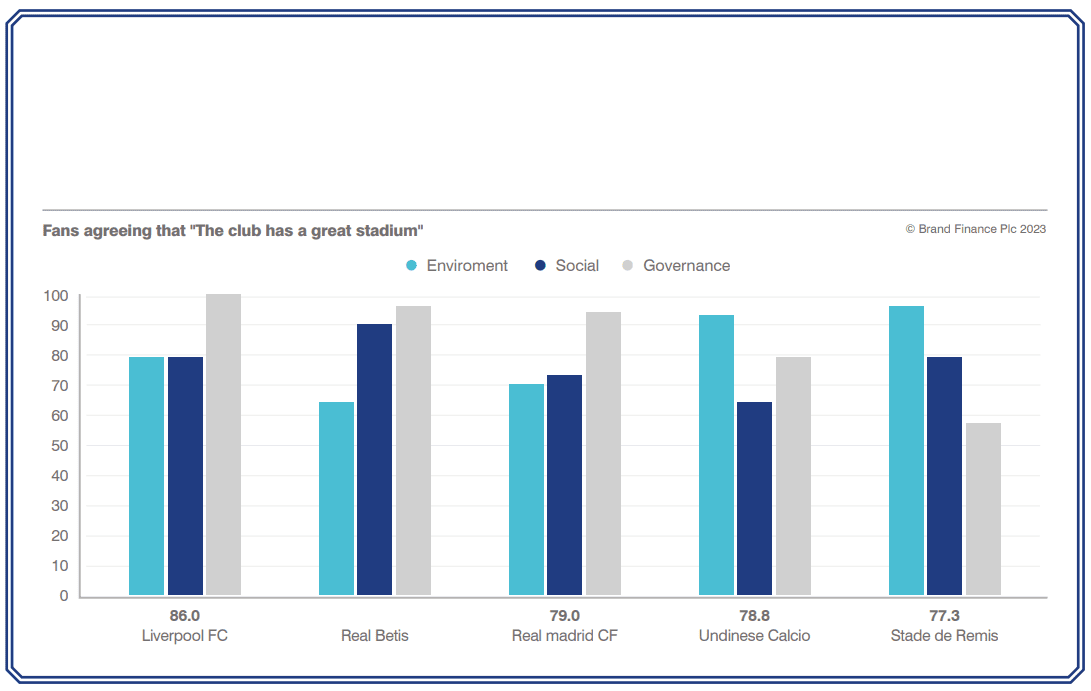
How can a club’s owners and executives navigate all this?
Andy: The design of stadia and arena over the past 20 years has been framed around the most easily measurable things. Things like construction cost, hospitality revenue, view quality and FIFA compliance. Aspects like the effect on fan experience, brand and sponsor attraction are harder to predict accurately. But just because something is hard to predict, doesn’t mean you shouldn’t try to predict it.
We feel strongly that there is another layer of sophistication, just as has happened in the world of player recruitment. And the approach shown below is unashamedly influenced by xG, expected goals.
A few years ago xG was a novelty, now it’s part and parcel of game analysis and complemented by alternatives such as expected threat. It’s exactly the same principle, predicting something that is hard to predict.
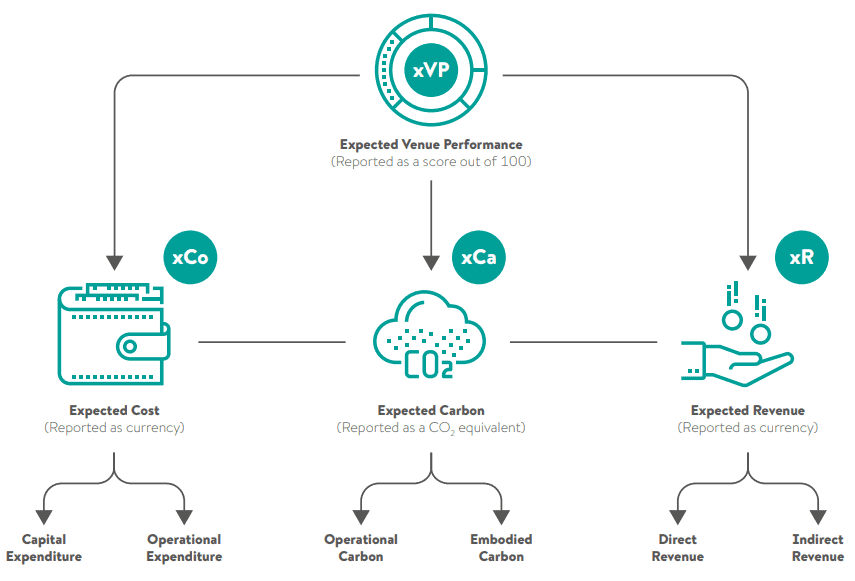
The following graphic considers two club journeys. One adopts a vision of being a force for good and designs with an aspiration to make this vision visible. The other makes entirely understandable decisions, but those based on short term gains and what can most easily be measured.
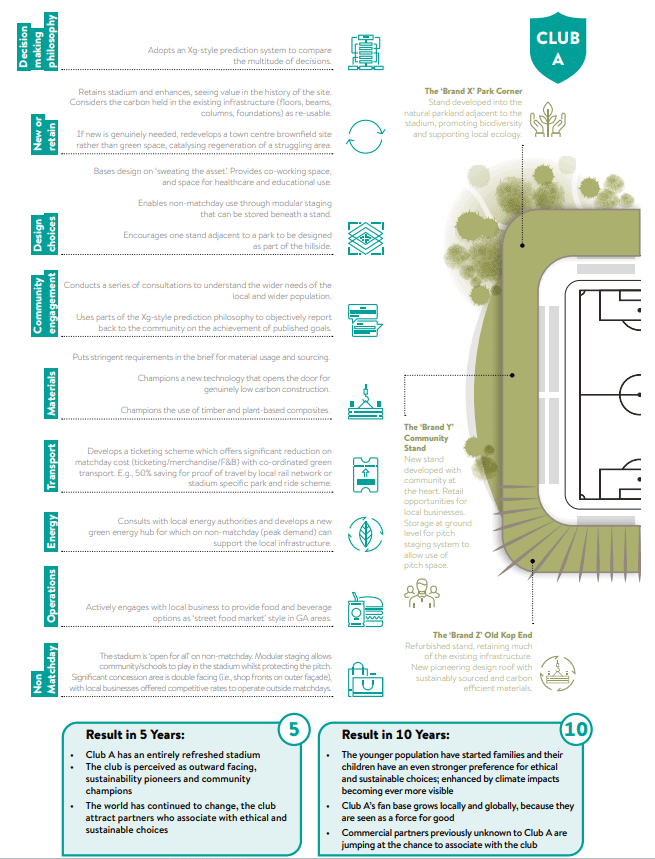
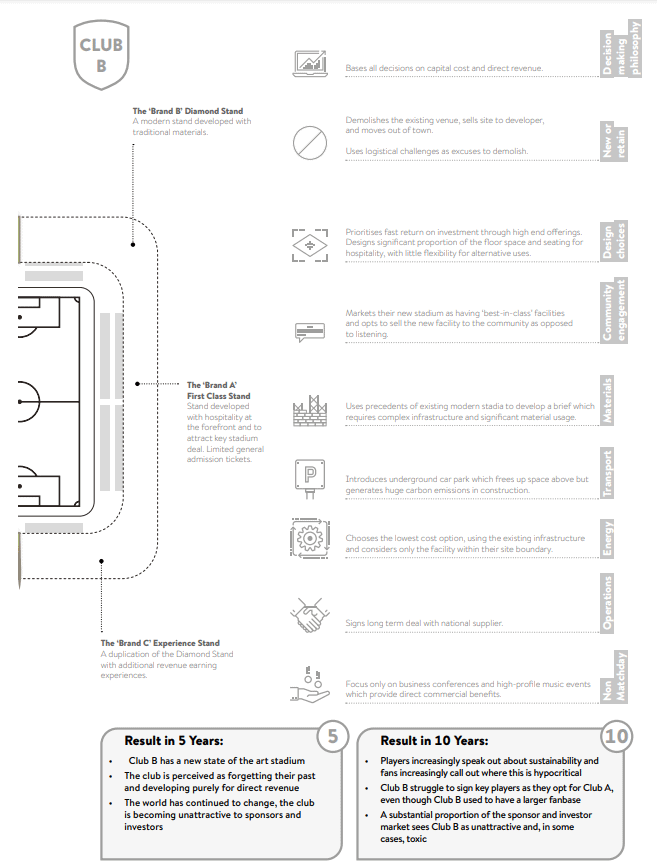
Which Club would you rather be? Which future will you choose?
Please get in touch and we would be more than happy to help you navigate the road (or rail, or path) ahead successfully. The opportunity is there. It’s not an easy opportunity, not an open goal or a tap-in, but Buro Happold and Brand Finance are on hand for the De Bruyne or Griezmann assist.

